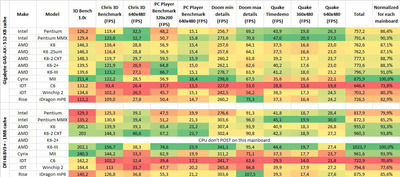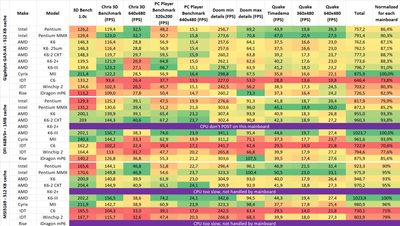First post, by Grosvince
- Rank
- Newbie
Hello all,
25 years and socket 7 era is keeping to fascinate me. So much CPUs available you can put in your mainboard !
So, I decided to grab one representant of each architecture for Socket7/Super7... I coulnd't imagine pay so much for some very obscure CPUs, but voilà ! Over the past years I succeed to grab on of each major architecture. And what to do with all of that ? Benchmarks !
I wanted to test every architecture at the same frequency (don't want to compare PR ratings, but actual MHz). I found that 200 MHz @66x3 would be the most common usable setup with my CPUs (some like Intel are locked, AMD aren't...). Unfortunately the K5 and 6x86 (M1) cannot run at this frequency, so they are excluded from this benchmarks at this time (if you have any ideas to compare this architechtures on par with the other ones, at a lower frequency...).
Here are the CPUs on my contest list :
- Intel Pentium
- Intel Pentium MMX
- AMD K6
- AMD K6 .25um (just to compare with the original K6; spoiler : this CPU is a pure die shrink)
- AMD K6-2 CXT (I cannot get my hands on a K6 2 non CXT...)
- AMD K6-2+ (this one is a late embedded part)
- AMD K6-III
- Cyrix MII (PR233, should run @75*2.5, but runs fine at 66*3)
- IDT C6
- IDT Winchip 2
- Rise iDragon mP6 (embedded version of the mP6, this one is a Lynx core in 180nm)
I used 2 mainboards :
Gigabyte GA5-AX (very compatible, it can handle all of the above CPUs), ALi Aladin V chipset with 512 kB cache
DFI K6BV3+ VIA MVP3 with 1 MB of cache.
2x 32 MB PC100 (clocked at 66 for the test)
Video : ATI Rage 128 Pro AGP.
All bios are the last stable version. Timing of ram are on "Fast" on GA5-AX and "Turbo" on DFI K6BV3+. Latency is on CL2.
First, I used Phils Computer Labs Dosbench collection (tests on Windows will be available soon, but I've experienced reboot issue with the Rise mP6 and 3DMark99, I'm looking for the issue - maybe a bug in the ATI driver ? Unfortunately my Riva TNT don't run on the GA5-AX). All tests were made on DOS 7.10 (boot from the Win98 install CD). I've run all benchmarks, and add all of the scores to make a global score for each processor, then the best CPU is granted with a 100% score, and the other follow. Unfortunately the DFI wouldn't handle my K6-2+. green is better performer, red is the worst
I think this results are pretty interesting (at least for me, nevertheless it was fun to do) :
What I can say :
What I see first is that results are best with the DFI, in a very clear way. Maybe I made something wrong on bios Setup ? Or is it only the amount of L2 cache ?
- MII is the best on Aladin V, K6 III is the best on MVP3
- Sometimes K6-2 is better than the K6-III, but why ?
- CXT core is an actual improvement (assuming that on this benchmarks, 3DKnow is not used)
- K6 250 nm is a pure die shrink, not doubt about it when looking at the result, so I decided not to test it on the MVP3 board.
- C6 is the worst performer
- Winchip 2 is better than the C6
- Intel CPU are better comparing to other on the Ali chipset
- 3D Bench 1.0c : MII is always the better by a huge margin ; mP6 and pentiums don't like this Bench
What are your thoughts ? I would be happy if you can help me to understand this results !



